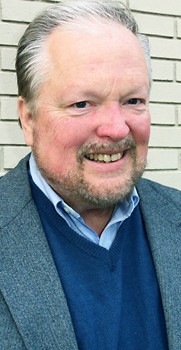Since retiring in 2009 after 16 years as pastor of First Presbyterian Church in Coeur d’Alene, Idaho, the Rev. Mike Bullard has served the church through his involvement in disaster relief. He’s now on the National Response Team of Presbyterian Disaster Assistance (PDA) and chairs the Inland Northwest chapter of Volunteer Organizations Active in Disasters (VOAD).
Soon after he retired, Ferry County experienced a storm with hurricane force winds. One person died. Many homes were damaged. The power was off for two weeks.
The Presbytery of the Inland Northwest asked Mike to help through PDA. He worked with the Rev. George Abrams, retired pastor of Cheney United Methodist Church, who works with the United Methodist Committee on Relief (UMCOR) on disaster response. The Federal Emergency Management Agency (FEMA) was also involved.
Finds ecumenical action
“I saw Southern Baptists come right away with chain saws, tarps and food,” Mike said. “Seventh Day Adventists went door to door and checked on people. George and I helped them set up a long-term recovery committee.
UMCOR provided funds for a caseworker to work for the committee. Presbyterian Disaster Assistance (PDA) provided funds for a caseworker to help people needing assistance.
“I was thrilled how each group had its own thing. It was clear which group was doing what. As a result, I became interested in disaster assistance,” he said.
Mike spent a year taking disaster relief training and discerning if his gifts matched their need. Then he joined the PDA National Response Team and that led to his involvement with VOAD.
VOAD coordinates efforts
VOAD operates on several levels — state, area-wide and national. There is one for Idaho, one for Washington and one for the Inland Northwest. VOADs provide regular communication and planning among states and counties. Their disaster planning includes faith-based organizations, FEMA, the Red Cross and animal organizations (to care for pets and provide comfort animals).
Mike saw one VOAD in action in the fire in Yarnell, Ariz.
“Because the VOAD in that part of Arizona was so active and prepared, there was a long-term recovery group active long before scammers arrived,” Mike said. “They pulled together the resources.”
In Yarnell, where half the town burned to the ground and 19 firefighters died, many houses were too old to be insured. Most people had little income and about half had no insurance.
“They pulled together because they had prepared ahead through VOAD. Their recovery was months ahead of any other area affected,” he said.
Each group has its role
Mike described the chain of events that takes place once a disaster strikes.
First to come in are the “badges, guns and ambulances.” Then come the utilities and those clearing transportation routes. These are government-related.
Then the red-shirted Red Cross workers and FEMA come.
FEMA can only provide services in a national disaster, but they are there from the start to evaluate whether the “disaster” gains that designation.
Mike said most of the larger religious organizations participate.
Yellow-shirted Southern Baptists come in to serve immediate needs. The blue-shirted Presbyterians come next. They offer compassion-fatigue seminars for first responders and support for affected churches.
Mennonites have a $30,000 kit for building a house. If a community recruits volunteers, they truck in materials and plans. Other groups are the Seventh Day Adventists, Catholic Charities, Jewish Charities and Islamic Relief.
All these groups operate under VOAD.
As Mike was determining whether to join PDA, Church World Service trained him in long-term recovery groups, and he had training through the Red Cross and FEMA.
PDA awaits an invitation
“Presbyterian Disaster Assistance never goes in unless invited by a Presbyterian church,” he explained. Once there, they will help anyone. After that, they contact the Red Cross and FEMA to connect on specific needs.
The disaster workers include an Emotional and Spiritual Care Team with trained counselors. They offer hospitality for work groups for long-term recovery efforts. They help a church install showers, beds and more so it can house recovery workers.
In addition, PDA operates a Christian summer camp for children and youth who have survived school shootings to work together to understand what they experienced in a spiritual context.”
Provide safety, spiritual care
The goal of disaster work, according to Mike, is not to put people’s lives back like they were, nor to make lives like they should be. Its goal is to see that people have safety, security, sanitation and spiritual care.
Disaster work gratifying
Mike finds the work gratifying.
“People are glad we are there. We are with them in a tough time. We can help,” he said.
After a worship service after the fire in Yarnell, “a woman came up to me and said, ‘I was bitter. Now I’m not.’ To me, that was a six-word novel,” he said.
After a tornado in Shawnee, a woman said, “We lost everything. In the 1993 tornado, I lost my first husband. Here we lost just stuff. It was nothing.”
Mike said strangers come up to him and other workers in restaurants and buy them food.
“It’s inspiring to see what people can and will do for each other,” he said.
Relief workers need training
Mike cautions people not to self-deploy. Well meaning people may go in wanting to help, but if they are untrained, they may create additional difficulties.
“People need to be trained and identified,” he said, encouraging people to volunteer with existing agencies ahead of time to take training from the Red Cross or a faith-based organization.
Mike attends Bethany Presbyterian Church in Spokane, with his wife, Betsy, who works with the Area Agency on Aging.

